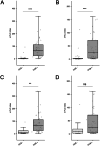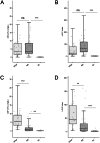Relevance of Kappa and Lambda Free Light Chains in Autoimmune Astrocytopathy Associated With Anti-GFAP Antibodies
- PMID: 40581835
- PMCID: PMC12455878
- DOI: 10.1002/acn3.70103
Relevance of Kappa and Lambda Free Light Chains in Autoimmune Astrocytopathy Associated With Anti-GFAP Antibodies
Abstract
Introduction: The kappa-free light chain (κ-FLC) index is known to be highly sensitive and specific for diagnosing multiple sclerosis (MS), while little is understood about lambda (λ)-FLC. This study assessed the κ-FLC and λ-FLC indices in autoimmune glial fibrillary acidic protein (GFAP) astrocytopathy.
Methods: This multicenter study compares κ-FLC and λ-FLC indexes among patients with autoimmune GFAP astrocytopathy and sex- and age-matched MS (positive control group) as well as symptomatic controls (headaches and small cerebral vessel disease, as the negative control group). We describe the correlation of both indexes with clinical variables and outcomes in the GFAP astrocytopathy cohort.
Results: A total of 93 patients were included (31 in each group). The median κ-FLC index was higher in the MS group (65.5 [35.7; 118.3]) compared to the GFAP astrocytopathy group (26.1 [11.4; 78.4], p = 0.062). With a κ-FLC index threshold of 6.1, the proportion of patients with a positive κ-FLC index was similar between the MS (94%) and GFAP-astrocytopathy groups (84%, p = 0.425). The median λ-FLC index was higher in the GFAP astrocytopathy group (45.5 [28.4; 96.9]) than in the MS group (10.6 [2.2; 29.1], p < 0.001). In the GFAP-astrocytopathy group, both CSF λ-FLC and the λ-FLC index at baseline were correlated with the last follow-up mRS (⍴ = 0.46, r2 = 0.088, p = 0.014, and ⍴ = 0.32, r2 = 0.12, p = 0.101, respectively).
Conclusion: The κ-FLC index alone cannot distinguish between autoimmune GFAP astrocytopathy and MS. We indicate a potential diagnostic and prognostic role of the λ-FLC index in GFAP astrocytopathy that needs confirmation in independent cohorts.
Keywords: autoimmune GFAP‐astrocytopathy; biomarkers; cerebrospinal fluid; kappa‐free light chains; lambda‐free light chains.
© 2025 The Author(s). Annals of Clinical and Translational Neurology published by Wiley Periodicals LLC on behalf of American Neurological Association.
Conflict of interest statement
M. Levraut received travel compensation from BindingSite, the company that markets Optilite. R. Marignier received consulting fees from Alexion and UCB, honoraria for presentation or educational events by Alexion, Biogen, Amgen, Roche, and UCB, and support for attending meetings by Alexion. M. Cohen received consulting fees from Biogen, Sanofi, Janssen, Horizon Therapeutics, Merck, Celgene‐BMS, Alexion, and Ad Scientiam. J. Benoit has nothing to disclose related to this study. C. Landes‐Chateau has nothing to disclose related to this study. E. Maillart received research grants from ARSEP and Biogen and honoraria for presentations or educational events by Biogen, Janssen, Merck, Novartis, Roche, Sanofi, and Teva. M. Cremoni has nothing to disclose related to this study. B. Seitz‐Polski has nothing to disclose related to this study. A.L. Pinto has nothing to disclose related to this study. P. Dumez has nothing to disclose related to this study. J. Honnorat has nothing to disclose related to this study. C. Lebrun‐Frenay was invited as faculty by ECTRIMS or the European Charcot Foundation.
Figures



References
-
- Simonsen C. S., Flemmen H. Ø., Lauritzen T., Berg‐Hansen P., Moen S. M., and Celius E. G., “The Diagnostic Value of IgG Index Versus Oligoclonal Bands in Cerebrospinal Fluid of Patients With Multiple Sclerosis,” Multiple Sclerosis Journal—Experimental, Translational and Clinical 6 (2020): 2055217319901291. - PMC - PubMed
-
- Saadeh R. S., Bryant S. C., McKeon A., et al., “CSF Kappa Free Light Chains: Cutoff Validation for Diagnosing Multiple Sclerosis,” Mayo Clinic Proceedings 97 (2022): 738–751. - PubMed
-
- Crespi I., Sulas M., Mora R., et al., “Combined Use of Kappa Free Light Chain Index and Isoelectrofocusing of Cerebro‐Spinal Fluid in Diagnosing Multiple Sclerosis: Performances and Costs,” Clinical Laboratory 63 (2017): 551–559. - PubMed
Publication types
MeSH terms
Substances
LinkOut - more resources
Full Text Sources
Medical
Miscellaneous
